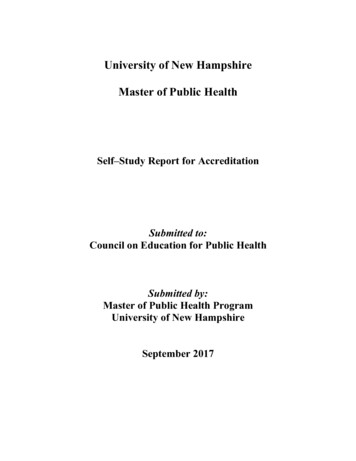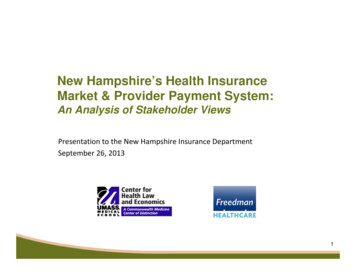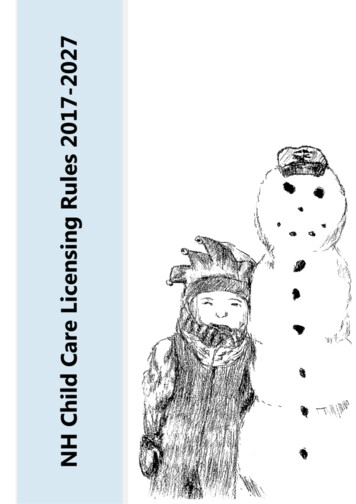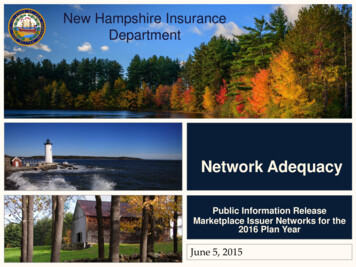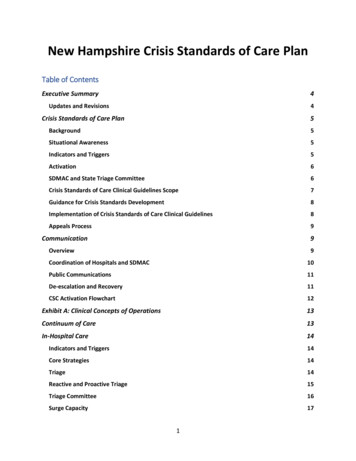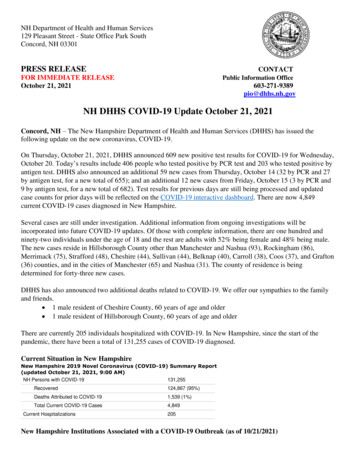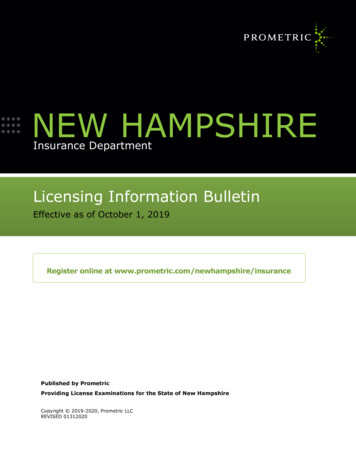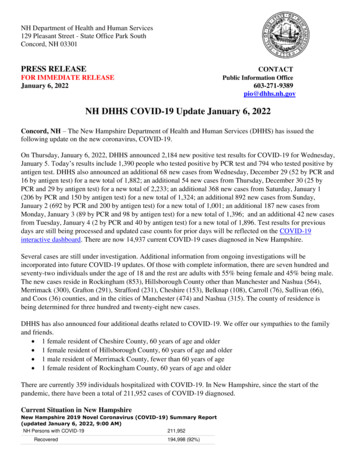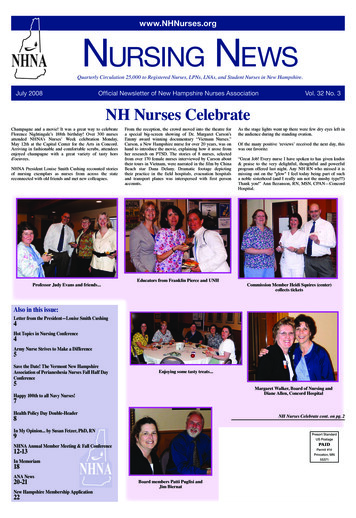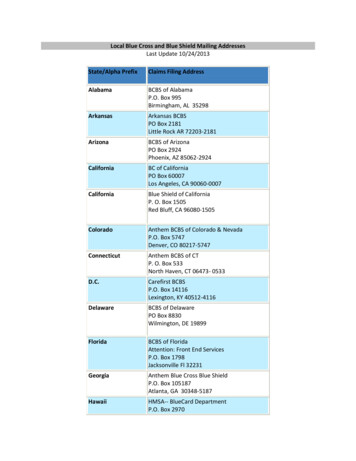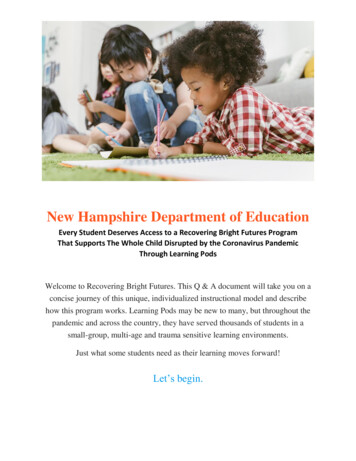
Transcription
New Hampshire Department of EducationEvery Student Deserves Access to a Recovering Bright Futures ProgramThat Supports The Whole Child Disrupted by the Coronavirus PandemicThrough Learning PodsWelcome to Recovering Bright Futures. This Q & A document will take you on aconcise journey of this unique, individualized instructional model and describehow this program works. Learning Pods may be new to many, but throughout thepandemic and across the country, they have served thousands of students in asmall-group, multi-age and trauma sensitive learning environments.Just what some students need as their learning moves forward!Let’s begin.
1Q: What is a Learning Pod, and how will this program help to Recover Bright Futures forNew Hampshire learners?A: Recovering Bright Futures is a program that partners with New Hampshire public school districts andfamilies to inspire students to love learning through its unique instructional model. Learning Pods, thatare facilitated by Prenda, utilize a proven mastery and project-based learning model to give students moreagency and autonomy in their learning. Prenda Learning Pods cater to 5-10 students per learning pod toensure children have the time to conquer their day, collaborate and create.Q: What grades are supported by the Recovering Bright Futures Program?A: Kindergarten - 8th-grade students grouping K-2nd grade, 3-5th grade, and 6-8th grade.Pictures photographed before COVID-19: Actual Prenda students during the Create and Goal Setting part of their day.Q: What type of student is best for this program?A: Students who thrive with more individualized attention and in small-group settings, especially thosewho have experienced learning loss due to the COVID-19 pandemic and need additional support to thrivein the traditional classroom. These students may be identified by the district, teachers, or by the parentsthemselves.Q: Who is Prenda?A: Prenda is a national leader in providing families with access to Learning Pod opportunities. Foundedin 2018 with its headquarters in Mesa, Arizona, Prenda serves thousands of students through its 430Learning Pods designed to support students’ mental, social and educational development in states acrossthe country.Q: Where will learning take place for Learning Pod students?A: Their normal school building, if the district has room to accommodate the students. Alternativelocations will be used if there is not space in the traditional school facility. Alternative spaces may includea local non-profit like the Boys and Girls Club, the town library, a child care facility, or other suitablelocation.
2An “empowered learner”:sets goals,holds themselves accountable,persists in the face of obstacles,collaborates with others, anddevelops their unique gifts as they make theirdent in the universe.Q: What makes the Learning Pod culture and learning environment unique?A: In addition to students mastering English Language Arts, Math, Social Studies and Science; studentslearn core values to support their personal development and social skills. Prenda Learning pods practicethe following daily values:Start with Heart caring about people and passion for learning.Dare Greatly courageously tackling the big goals aheadFigure it Out utilizing problem-solving skills to foster growthFoundation of Trust considering trust in every interactionLearning Comfort stepping out of comfort zones to achieve more
3Q: What is the typical school day of a Learning Pod student?A: Students are guided through the Learning Model by a certified Prenda guide.Prenda Learning ModelConquer-Students work through coreacademic subjects with thesupport of a guide using cuttingedge learning tools that adapt tostudent performance and requirethat students master materialbefore they move on.CollaborateA structured group activity toachieve a higher level ofunderstanding than any oneperson could achieve alone.Examples: discussion, debate,collaborative research, mathapplication puzzles, scienceexperiments.-CreateStudents work in pairs or smallgroups to build cross-curricularprojects. We provide promptsthat invite learning in STEM,history, research, writing,presenting, performing, art,mindset, and healthy habits.Q: Who leads students’ day-to-day learning activities?A: Certified Prenda Guides who go through specific training and are supported by a New HampshireCertified Teacher, with oversight by a Regional Administrator.Parent to Guide Testimonial:“Prenda has given my son new excitement for learning. I see amazing growth in him. The guides trulycare and help to create an environment that invites learning and growth.”— M.B., mom.Q: What are the parent and guardian responsibilities in partnership with their LearningPod?A: Guides, parents, and students meet to make curriculum decisions, support the student in settingreasonable but ambitious goals based on individualized student data, review progress, and address studentaccommodations and adaptations.Q: Do parents get to choose their child’s guide, and what is the process?A: Yes. Parents often have someone in their community who would be an excellent guide for theirchildren, so they ask them to lead a Learning Pod. The local District may have a qualified teacher whocan serve as a guide. Parents and guides are encouraged to meet to make sure the Learning Pod will be agood fit.Q: Who are the technology partners supporting individualized and adaptive learningpaths?A: Lexia (decoding, grammar, reading comprehension, spelling), NoRedInk (grammar and writing),
4Lightsail (reading comprehension), Khan Academy (math), Zearn (math), Dreambox (math), and ourvery own Treasure Hunt Reading.Q: How do students stay organized using the on-line learning tools?A: Students have access to Prenda’s proprietary software, PrendaWorld. Working closely with theirguide, students manage their learning tools, set goals, and hold themselves accountable.Q: Do Learning Pod students learn the same curriculum other students are learning in theclassroom?A: Students learn using an individualized path aligned to state standards. This mastery-based approachpositions the student for academic success. The learning is aligned to the state academic standards so thatstudents can stay on track with their peers.Q: Are Learning Pod learning programs aligned with state educational standards?A: Yes. Learning programs are aligned with New Hampshire Academic Standards adapted to theindividual student.Q: How will student performance data be reported to the school district?A: Prenda will provide quarterly updates on student performance criteria directly to a district sitecoordinator (i.e., a point-of-contact between the district and Prenda). Students participating in a LearningPod will be required to participate in the Statewide assessment, NH SAS.Q: Are letter grades given for subjects, and how do students measure progress?A: Districts may use the quarterly data, which could include iReady benchmarks, progress in learningtools and other data to assign grades and report cards as determined by the district. The students measureprogress by setting personal learning goals during the Conquer part of their day. This learning model ismastery-based and encourages students to move on when they are ready.Q: How do guides support students when they face a learning challenge?A: Through a three-step process where they 1) try to solve the problem independently, 2) ask peers forhelp, and 3) work through the knowledge-finding process with their guide.
5Q: What if a student starts in a Learning Pod and is ready to transition back to theirregular class setting?A: Students can return to their regular class setting at any time.Q: How does Prenda support students from underprivileged homes and environments?A: Prenda takes a strategic, multi-faceted approach through its Equitable Alliances (EA) Team. The EAteam helps parents and guides find additional resources to help serve students who have experiencedtrauma, with more socio-emotional support and finding helping support for an extended day, food, andtransportation, where those resources are available. Learning Pods are hyper-localized, sometimes eveneliminating the need for transportation. Guides obtain tools to provide emotional support and safelearning environments.Q: How satisfied are students with Prenda’s Learning Model, Core Values, and Culture?A: In weekly “Student Happiness” surveys, on average, 82-87% of Prenda students select “Happy” or“Very Happy.”Q: How satisfied are parents and guardians with Prenda’s Learning Model Core Valuesand Culture?A: Parents regularly take a “Parent Happiness” survey.On average, 92% of our parents indicate“Happy” or “Very Happy” in this survey.Q: Who can apply for the Recovering Bright Futures Grant Program?A: Any New Hampshire public school is eligible to access a Learning Pod through the RecoveringBright Futures Program. Students from multiple school districts may be combined at one Learning Pod.Parents and guardians will enroll students by visiting the Prenda website, prendaschool.com.
6Q: If a district receives a grant to create a District Learning Pod, can they deny any oftheir students from participating?A:If a district chooses to create a District Learning Pod, it must serve any interested district students asavailability allows. No district is forced to apply for a grant and create a District Learning Pod.If a parent does not have access to a District Learning Pod and would still like their child to participate, aCommunity Learning Pod option is available. Parents can complete an application on-line or contact theDepartment of Education (LearningPods@doe.nh.gov) or Prenda for more information on this option.Q: Is there a cap for the number of students who can participate in the Recovering BrightFutures Program?A: The only limitation is funding availability. The State will attempt to fund as many students needingthis option as possible. Once accepted into the program, unless a student exits early, they have this optionfor the entire 2021-2022 and 2022-2023 academic school years.Q: What happens when a district decides to enroll a student with District Learning Pod?A: Once a district is notified that a student will be participating in a District Learning Pod, the districtwill provide Prenda the necessary documentation, including but not limited to IEPs and 504 plans, as wellas the state student ID number (SSID). Prenda requires a minimum of one week to complete an internalenrollment process for the student.Q: What happens when a family decides to enroll a student in a Community LearningPod?A: Students enrolling in a Community Learning Pod will be required to complete an intent to HomeEducate and follow New Hampshire RSA 193-A. Information about this option is available from theDepartment of Education here.Q: How will this impact the school district’s accountability metrics?A: Students participating in a Learning Pod will be required to participate in the Statewide assessment,NH SAS. This includes students both in District Learning Pods and Community Learning Pods.Q: How does student attendance work?A: Attendance for District Learning Pods will follow District practices. Community Learning Pods willdevelop a localized learning pod specific attendance approach.Q: How is the tuition for the Learning Pod paid?A: The Department of Education through federal COVID-19 recovery grants will fund a student’s tuitiondirectly to Prenda for up to 2 years, contingent on the student’s eligibility and grant funding. The districtdoes not have to be involved in that aspect of the administration. There is no cost to the parents or theschool district.
7Additional questions? ContactKatie MurphyNH Department of EducationEmail: Susan.K.Murphy@doe.nh.govFor more information about Prenda in New Hampshire please visithttps://prendaschool.com/new-hampshire
1 Q: What is a Learning Pod, and how will this program help to Recover Bright Futures for New Hampshire learners? A: Recovering Bright Futures is a program that partners with New Hampshire public school districts and families to inspire students to love learning through its unique instructional model. Learning Pods, that are facilitated by Prenda, utilize a proven mastery and project-based .
